Garthamlock
Garthamlock first appears on maps from the 1750s, as a tiny settlement called ‘Garthamloch’. The lands around Garthamlock were at one time owned by the Harvey family, who went on to make their fortune in whisky, as Glasgow’s distilling industry grew rapidly in the 19th century. At this time Garthamlock was one of a number of small villages in this rural area, where most people worked as farmers, or as miners at the small coat pits that dotted the landscape.
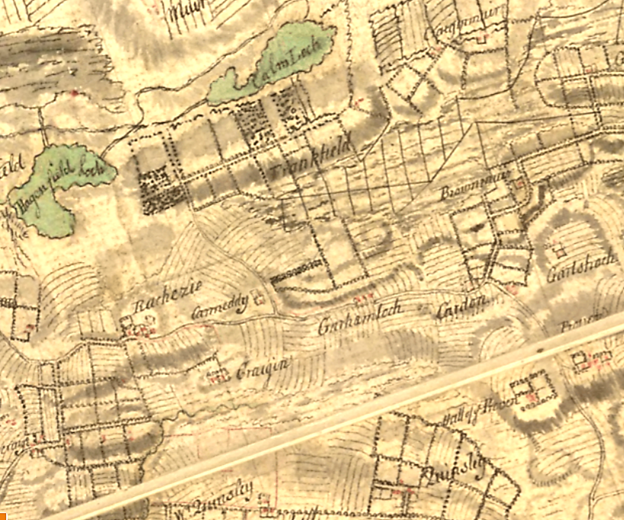
Ref: ‘Garthamloch’ in the centre of the map, with Frankfield Loch (labelled ‘Calm Loch’) to the north. The rows of parallel lines all around indicate farmed land. From William Roy’s map, 1752-55. National Library of Scotland
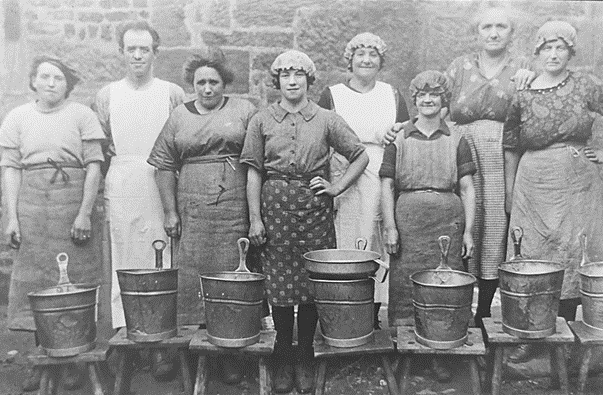
Ref: A group of milkmaids at Garthamlock Farm, date unknown. East Dunbartonshire Archives
Coal
The coal industry in the area grew rapidly when the Monkland Canal was opened in the last decades of the 18th century. This new transport route made it much easier to transport coal from the Monklands area (around Coatbridge), where it was abundant, to the city of Glasgow. Around the same time, technological innovations made coal easier - and therefore cheaper - to extract. This meant areas along the route of the canal, where coal also lay beneath the ground, began to be mined to exploit this rich natural resource. More people moved to the area to work in the mines, and tiny villages including Garthamlock, Ruchazie and Easterhouse steadily began to grow.
Farming and coal would continue to be the dominant industries in Garthamlock for the next hundred years or so. Whole families would work in the mine, with boys being sent down the pit as young as twelve to work 14-hour days, and women often spending time sifting through the rubbish piles to separate out any small pieces of coal that remained.
Even as late as 1910, the Garthamlock mine employed 175 men. The village at this time was still small, however - around seven families lived in the miners’ cottages that had been built by the mine owners, and the other workers rented accommodation in Shettleston, Millerston, or Glasgow, and commuted to work in the pit each day.
Garthamlock House
While miners and their families worked to extract coal in this lucrative industry, one of the mine owners lived at the mansion house which was the only other major landmark in the area for miles around - Garthamlock House.
It is thought the house was built in the early 19th century and was described as being “a superior dwelling house having offices and garden attached”. The house was sited around where the present day Craigend and Garthamlock Parish Church now stands.
Garthamlock House was one of several mansion houses scattered across this rural area, miles from the dirty, noisy city of Glasgow. Blairtummock House, which still stands today, is another example. These were the homes of wealthy merchants who ran their businesses in Glasgow and bought (or built) themselves large stately houses in what was then relatively peaceful countryside.
In the 1860s, Garthamlock House was the home of James Panton, who owned the local coal mines, and the shop where the mining families bought food and other supplies. As was common practice at the time, the miners were heavily encouraged (if not forced) to spend their wages at that shop - and nowhere else - allowing its owner to charge higher prices and recoup much of what he had just paid out in wages. One manager of the Garthamlock shop, when questioned for a report about how miners’ stores operated in 1871, said:
The men did not get the worth of their money. They got the best bread, and the tea was fairish, but the sugar was [half a penny per pound] dearer than in Glasgow, and not so good. They had just to take what they got. The cheese was above the ordinary price. Mr Panton himself looked after the men's going to the store. Our profit would be a good deal more than a retail tradesman would have made.
As well as raking in a healthy profit from the mines and the store, James Panton also ran a business from Buchanan Street in Glasgow, importing musical instruments, and dealing in watch and clockmaker’s tools, fishing rods and tackle.
James Panton died in 1870, and it is not known who lived in Garthamlock House after this. By the 1950s, the house lay empty, and it, along with Blairtummock House, were bought by the Glasgow Corporation (a precursor to Glasgow City Council) as they annexed lands on the outskirts of Glasgow to build the new housing schemes that would come to dominate the area.

Ref: Garthamlock House, pictured in 1955.
https://vm.colinwaddell.com/search/?&tags=Garthamlock
While Blairtummock House still stands and has been renovated and adapted for various uses over recent years, Garthamlock House was demolished and Garthamlock Secondary School built in its place. The school opened in 1960 to serve the growing population living in the new houses, but it too has since been demolished.
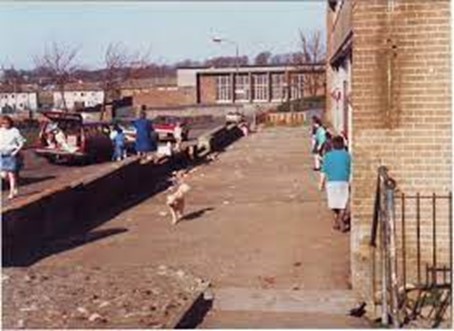
The Transformation of Garthamlock
After the Second World War, Glasgow was facing a huge housing problem. Thousands of people lived in crowded, unsafe and unhealthy conditions in tenement housing in older parts of the city, and Glasgow Corporation needed to find somewhere to rehouse them.
Housebuilding began in Garthamlock in 1953, around the same time as in neighbouring Easterhouse, Ruchazie and Cranhill. 2,000 houses were planned in the first phase, which would see a huge influx of families from crowded Glasgow neighbourhoods settle in this formerly quiet, rural area.
Cathy Paul’s sister moved to Garthamlock in 1955. Writing in 2005, she recalled the conditions in which her family and others had been living in Bridgeton, in Glasgow’s East End:
I lived in a room and kitchen in Bridgeton. We had an outside toilet and no running water. The kitchen, which measured around 12ft x 12ft, served as a living room/ kitchen/ dining room. It had a hole-in-the-wall bed so it was also a bedroom. The bedroom measured around 12ft x 9 ft and we had two beds and a wardrobe in it. At this time there were four of us living there - my mother, father, brother and me. Previously there had been as many as seven living there.
By contrast, she remembered her first visit to see her sister in one of the new houses in Garthamlock:
When my mother and I went to visit my sister in Garthamlock we had to walk the length of Porchester Street when we got off the bus. This took us about an hour because we would stop to look in absolute wonder at the gardens, which were filled with flowers and greenery, and some people had built little rockeries. Some even had fishponds in them. It was like going to the country. My sister’s house consisted of two bedrooms, a living room, and a separate kitchen! And a bathroom! It seemed like a palace to me.
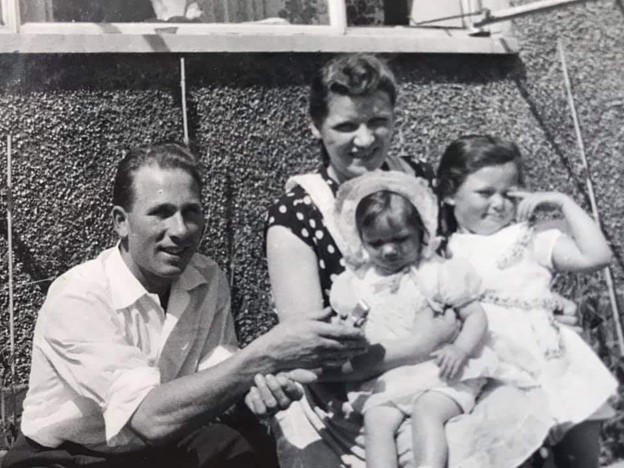
Ref: Isabella Doonan’s family, Guildford Street, around 1958.
View on Facebook
To those who had just moved from cramped and dirty inner-city conditions, moving to Garthamlock felt like being in the countryside. Brian Toland, who grew up in Garthamlock, remembers:
Garthamlock, just across there [...] there was nothing over there except for fields as far as you could look. You just walked out your door, top of the street and that was you in the country, and away yous went.
Having freedom and open space was a novelty to the young people of Garthamlock, who didn’t waste time getting into trouble! Brian recalls one particularly memorable incident:
Me and my brother, we decided we would go across the fields, and a farmer had cut all his hay down, and he baled it all into bales of hay and stacked it. And me and my brother and four other people went into that field and decided we would play over there and we knocked it all down. And the farmer turned up with a shotgun and we all got the jail! Eleven years old, we all got the jail. We got taken to Millerston Police Station, where the garage is, just at Millerston - see the wee houses, that was the police station - and we got locked up in a cell, and we had to wait there till our Ma’s and Da’s came and got us. And then we ended up in court, and we all got fined £5 each [...] Ooft I suffered for that for a long time.
While being in the country had its temptations for some, there were downsides to living on a brand-new housing scheme. At times, residents felt very cut off - Garthamlock had no public phone boxes for the first few years after the houses were built, at a time when home telephones were far from universal. Residents who moved there in the early years also complained that it took the fire brigade too long to respond in an emergency - with Garthamlock having no fire station of its own, and fire engines having to be sent from other parts of Glasgow.
Quarry
The new houses at Garthamlock weren’t universally welcomed. Having been mainly used as farmland and for coal mining, the area had also been home to quarries since the late 19th century. In 1952, just before the building of new housing at Garthamlock started, the Alexander Transport Company had been granted permission to operate a large quarry at the eastern end of Garthamlock for the following 20 years. They lodged an objection to the building of the new houses, claiming it would be too dangerous for any children to live so close to an operating quarry.
The housebuilding went ahead anyway, and children who grew up in Garthamlock remember happy - if no doubt dangerous - hours spent playing in the quarry. Brian Toland recalls:
[We had] plenty of things to do, know what I mean? OK, you’ve not got computers and all the rest and that kinda stuff. You went out and you made your own thing. Go up to the quarry in Garthamlock - used to be a big quarry in Garthamlock where the Fort is - and climbed down that quarry face, oh, oh!
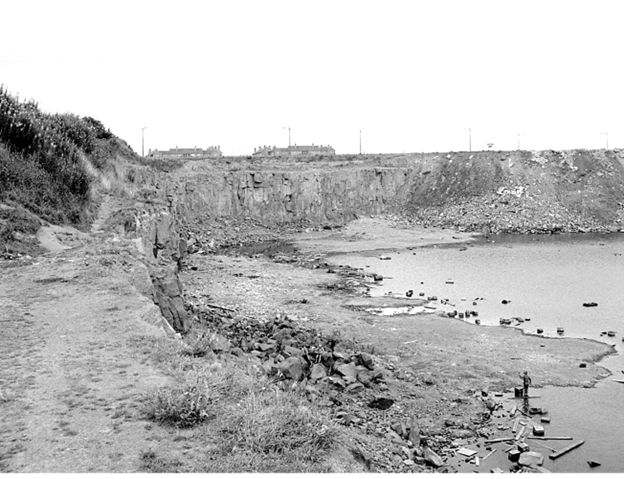
Ref: Garthamlock Quarry, pictured 1969. Spot the wee boy playing in the foreground and the houses of Garthamlock in the distance. Canmore.
https://canmore.org.uk/collection/712954
Water Towers
To this day one of the most distinctive features of Garthamlock, the water towers which dominate the skyline were put up around the same time as the new housing. The huge new schemes that had sprung up in the area meant new measures had to be taken to supply the tens of thousands of people living there with mains water.
Built in 1957, the first water tower at Garthamlock was at the time the highest in Britain, and had the largest capacity, capable of holding a million gallons of water.
The towers have remained a distinctive feature of the area and hold a special place in the heart of those who have grown up in Garthamlock. Gary McDonald, writing around 2005 remembered:
My memories are of Cambusmore Road next to the two large water towers. There were so many children about. We played football on the flat surface, as there were no cars to stop us playing. In the 70s and early 80s it was a great place for kids to play. There were no drugs and everyone seemed to be friendly.
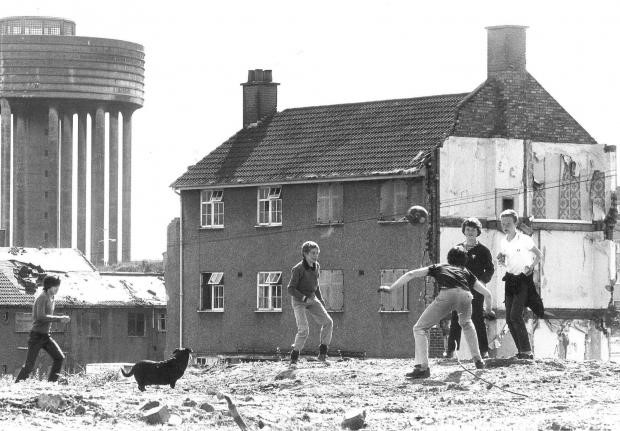
Ref: Boys play football in Garthamlock, 1981. Glasgow Times.
https://www.glasgowtimes.co.uk/news/23422609.pictures-glasgow-looked-like-80s/
1970s
As with other housing schemes built in the 1950s, by the 1970s Garthamlock was beginning to face challenges. The houses themselves, built so quickly and from materials like concrete that were cheaper and easier to use, were beginning to deteriorate.
Against a backdrop of increasing unemployment, and with the lack of amenities discouraging people from staying there, the 1970s was a time of growing community action in Garthamlock, as it also was in Easterhouse and Ruchazie. It was a time when those who had moved there as children, or been born there, were beginning to raise their own families there, and many wanted to work together to try to improve things for the area.
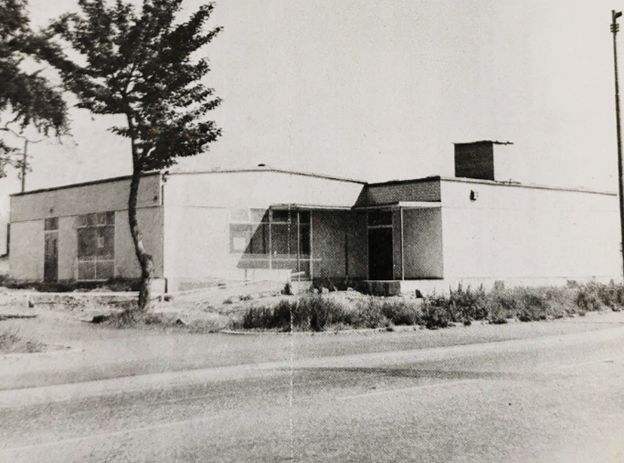
Ref: Garthamlock Tenants Social Club. Image taken from Community Action: A Working Handbook for Groups in Easterhouse, Barlanark and Garthamlock, 1975.
Tenants’ associations were formed in the new schemes throughout the 1970s, and often got involved in campaigning to improve local housing conditions, as well as organising social activities. Garthamlock Tenants’ Association built a social club for local residents with a loan from a brewery, and with nowhere else to go in the community, it quickly became a popular venue, hosting ladies’ nights, bingo, games nights, darts competitions and discos.
Work was due to start on a new council-built community centre in 1976, but this would not finally materialise until 1981. In the meantime, Garthamlock locals carried on organising themselves to bring much-needed amenities and services to their community.
1977 saw residents get together to organise Garthamlock’s first gala week. Brian Toland remembers the sense of occasion having a profound effect on the community:
Garthamlock had the very first ever gala day anywhere, and they had it in Craigend Primary School which was at the bottom of the street. They had just made a new football pitch so that’s where the gala day was. They had pipe bands and they had the archery [...] It was fantastic, for a full week. Wee gala queen coming off the back of a coal motor, by the time she got off it she was poking bogging! They never cleaned it; her all-white dress wasn’t white when she came off the back of that. June, July, all the big signs were put up along the fences at shops and everybody took a wee part in it. People used to do home baking and just bring it all down, you know what I mean?
The late 1970s also saw new community groups springing up, with locals volunteering to help others at a time of increasing need. Following the opening of the Easterhouse Citizens Advice Bureau, a tiny makeshift satellite office was opened in Garthamlock, crammed into the rear of a local church. Three women volunteers helped locals check they were getting the benefits they were entitled to - in a community that was among the most impoverished in Scotland - and advised others on setting up tenants’ groups of their own.
Maureen Ferrie formed Greater Easterhouse Supporting Hands (GESH) in 1979. Based first in Lochend Secondary School before a move to Cranhill and then settling in Garthamlock, the project took over a council-owned community facility that had lain derelict for years and been marked for demolition. The project provided a hub for people with physical and learning disabilities, and now still operates as a social venue with a varied weekly programme serving people from Garthamlock and beyond.
Despite growing community action in the 1970s, Garthamlock faced its share of problems. In 1978, half of the men living there were out of work. A report cited 70% of families saying they wanted to leave, and in the space of one year, 129 families did ‘moonlights’ - abandoned their houses to move elsewhere. Many of those wishing to leave did so because of violence and vandalism in the area - in one year, the cost of vandalism to houses in Garthamlock was estimated at £77,000 (the equivalent of nearly half a million pounds today). With a large number of empty and deteriorating houses, the scheme was starting to look dilapidated, and social problems exacerbated issues further.
Gangs were a problem in many of the new housing schemes, as young people were growing up with no job prospects and nothing else to do. While the violence wrought by the gangs could be devastating when things got out of hand, many living in these communities at the time remember simply day-to-day petty rivalries and mischief. John Duffy’s father was the janitor at St Philip’s school in Ruchazie in the 1970s. He remembers:
I think Ruchazie and Garthamlock, it was the YY’s and the Tolls, and they used to cut through the school at night when my dad used to be shutting the gates at 10 o’clock at night. And they’d say, ‘You alright Mr D?’ My dad would be like, ‘Alright lads, c’mon I’m locking up.’ And they would be like, ‘Sorry, sorry sir, sorry sir,’ you know. And they would just cut through the school at night and my dad would lock the gate and they would chat away to my dad.
1980s
The community centre that had been promised in the mid-1970s finally opened in 1981, off Gartloch Road. (It was the same centre that would later lie abandoned before being taken over by GESH in the 1990s). The centre had a gym that doubled as a concert hall, snack bar and workshops. In its early years, it was a much-welcomed addition to the area, bringing sport and social activities, particularly for young people.
The 1980s also saw a programme of regeneration on Garthamlock’s housing stock. Houses that were in salvageable condition were upgraded with central heating and new wiring, while other areas saw whole blocks of dilapidated housing demolished.
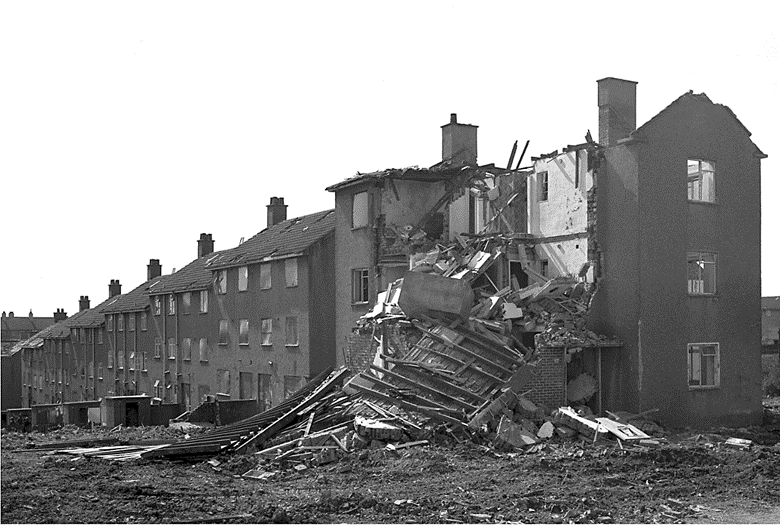
Ref: Bavelaw Street being demolished, 1981. Canmore.
https://canmore.org.uk/collection/674846
The City of Glasgow District Council also invited in private developers to ease the financial burden of updating so much run down, unlettable property. In exchange for demolishing the crumbling tenements and transferring ownership of the land, private building contractors then built new, replacement houses. The idea was to pass the savings on to new owners, providing low-cost housing for sale, rather than rent, for the first time in any of Glasgow’s postwar housing schemes. At a time when Prime Minister Margaret Thatcher’s right-to-buy scheme saw one in three council-built houses across the UK purchased by their tenants, taking them into private ownership, the hope was to provide the same opportunities for people in Garthamlock.
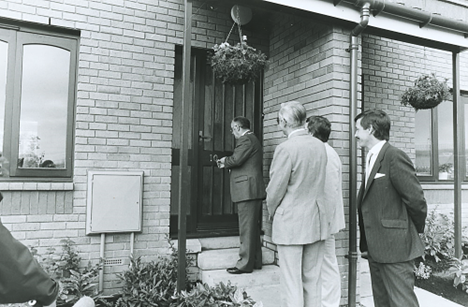
Ref: Lord Provost Robert Gray performs the key-turning ceremony at the showhouse at 10 Ref: Blackfaulds Gardens, Garthamlock, to formally open a new housing development, November 1985. Glasgow Story.
https://www.theglasgowstory.com/image/?inum=TGSA05121&t=2
But the demand for owner-occupied housing wasn’t as high as the council and building contractors had hoped, in an area where unemployment was still a major issue and many residents’ income came from benefits. Other amenities provided by the private housebuilding companies as a condition of their contracts were poorly planned. One developer’s gesture to the community was to build a BMX track, which lay unused as families could not afford to buy the bikes.
1990s
The 1990s was still a time of economic hardship for many in Scotland, particularly Glasgow. In the 1990s, Garthamlock had the highest rate of unemployment in Scotland at 30% - the second highest in Britain.
While some attention was being paid to regeneration in neighbouring communities, those living in Garthamlock often felt left behind and forgotten. Brothers Duncan and Brian Wilson formed Garthamlock Community Enterprise with other concerned residents in the early 90s, establishing an arts project and a boys’ football team. At the time, Duncan Wilson was quoted as saying:
We have been ignored out here for too long. It is out of sight, out of mind, five miles from the city centre. We don’t even get as much as Easterhouse because we are part of the Greater Easterhouse Initiative and anything that is going, goes to Easterhouse itself, not Garthamlock.
When local primary school St Thenog’s was closed, it was put up for sale by Strathclyde Regional Council. Garthamlock Community Enterprise put in a bid to take over the site and create units for small businesses, a hall and community sports facilities. Other proposals were made, including to replace the school with housing for disabled people and a respite centre for family carers, but ultimately a plan to develop even more private housing won out. The school was bought by developers, but the promised housing did not materialise for years, with the site laying derelict in the meantime.
Since 2000
The Greater Easterhouse area continued to see development and regeneration into the new millennium, with £400 million of public and private sector investment in the 2000s and 2010s.
In 2001, planning permission was granted to develop a new shopping centre on the site of the old Garthamlock Quarry. The quarry was filled in, and after years of work, in 2014, Glasgow Fort was opened, bringing jobs, amenities and visitors to the area.
The history of Garthamlock is to some extent the history of its houses - from the 19th century Garthamlock House, symbol of the unequal power between wealthy landowners and the farmers and miners who worked on their land, to the postwar housing that epitomised the hope of a new future. It was problems with this housing that contributed to, and exacerbated, other social challenges in Garthamlock and neighbouring areas in the subsequent decades. Now, as the community continues to evolve, it is the site of increasing numbers of private houses, including the Beeches development built by Persimmon in the 2010s.
While housing has shaped this community, it is the people of Garthamlock, from farmers and miners to inner-city exiles and modern-day residents, who have made it home.






